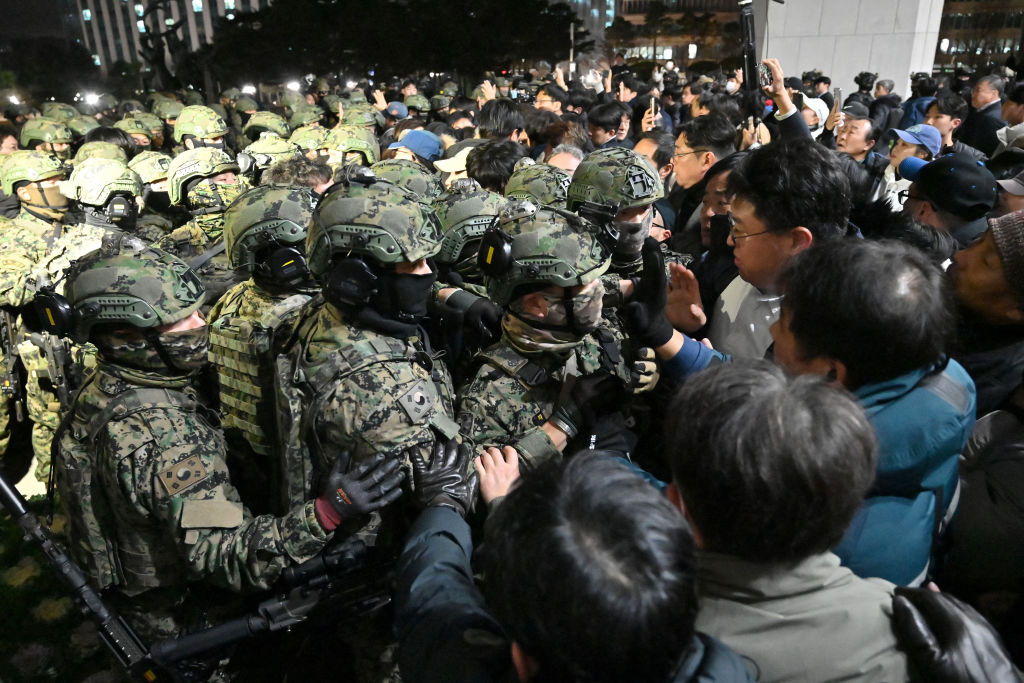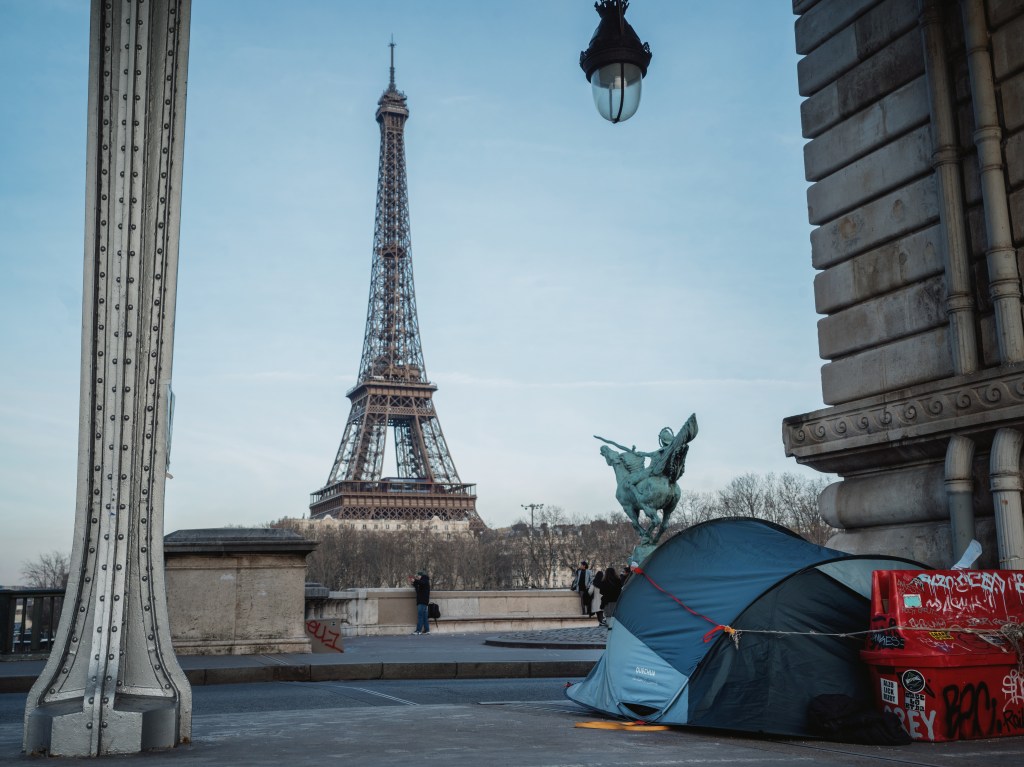Yesterday afternoon South Korea’s President Yoon Suk Yeol made the shock TV announcement that he was putting his country under martial law. According to Article 77 of South Korea’s constitution, the People’ Power party President was within his rights. But why?
Yoon wheeled out the standard coup trope that he needed ‘to restore order’. He argued that South Korea needed to be rescued from South Korea’s left wing Democrat party which won a majority in the unicameral National Assembly in April. Yoon accused of the Democrats of putting the country at risk from communist North Korea. But his problem was the absence of an emergency. Without that Yoon’s declaration of martial law could only be seen as a ham-fisted coup d’etat.
The popular reaction was immediate. Members of the National Assembly raced to the parliament in Yeongdeungpo-gu. Some 190 of them got there before the army. Some even climbed walls and fought police to get inside. They voted unanimously to lift the declaration of martial law. Meanwhile, outside, pro-democracy protestors blocked the army from entering the National Assembly. Yoon called a cabinet meeting and capitulated. Martial law was lifted.
The fact is that in the last 40 years South Korea has become a wealthy country. Democracy is now embedded. However, the country faces extreme political division. Feisty Democratic majority leader Lee Jae-Myung, who was stabbed in the neck while visiting the southern city of Busan earlier this year, has accused Yoon of presiding over a ‘prosecutorial dictatorship’ and ‘waging an outdated ideological war’ and ‘anti-state activities plotting rebellion.’ Lee is being prosecuted for breaking electoral rules. But unlike the United States over recent years, lawfare appears to be being waged on both sides. President Yoon and his wife are similarly facing charges of electoral fraud, influence peddling and stock price manipulation.
Now that Yoon has backed down not only under pressure from the Democrats but also from his own PPP, the stability of his presidency is certain to be called into question. Impeachment that was being talked about before the coup will now almost certainly follow. Despite the relative stability of democracy over the past few decades, it will not be lost on the electorate that Korea has been suffered extraordinary political and military violence over the last century. Coups have not always been so bloodless. Violent death is one of the main themes of modern Korean history.
In 1895 when Korean vassalage was resisted by Empress Myung-Sung (aka Queen Min), Japan’s consul organised a group of sword-wielding Japanese samurai to assassinate her. In the early hours of 8 October Queen Min was dragged out of her royal residence and hacked to death.
Korea continued to be the butt of Japan’s imperial advances in the 20th Century. After the Russo-Japanese war, mediator President Theodore Roosevelt fudged the Korean issue by guaranteeing its freedom while at the same time recognising Japan’s ‘paramount political, military and economic interests in Korea.’ Subsequently Korea’s prime minister was murdered after he was lured out of a cabinet meeting. Afterwards its government was then forced to accept a Japanese protectorate. Then, when an appeal was made to America for help, the Japanese army slaughtered 50,000 mainly Christian, pro-Western Koreans.
This was just the beginning of Korea’s 20th Century miseries. During the Pacific war, over a million Korean men were forced to work as slave labourers while 200,000 Korean women were coerced into prostitution to service Emperor Hirohito’s armies. Korean dissidents suffered vivisection and biological experimentation in Japan’s R&D concentration camp, Unit 731, near Harbin in Manchuria.
Worse was to come. After the Pacific war, the north’s socialist dictator, Kim Il-sung persuaded Russia to back his invasion of the American occupied south. In the resulting war 2.5 million Koreans died, about 10 per cent of its population.
The state of war with North Korea has continued ever since. In 1974 President Park Chung-hee’s wife was assassinated by a North Korean gunman. On the 26 November 1979, Park sat down to dinner with Kim Jae-gyu, his Director of the Korean Central Intelligence Agency [KCIA]. After an argument, Kim pulled out a Beretta and shot the president. When the pistol jammed, Kim left the room and borrowed a Smith and Wesson. The wounded Park escaped to a bathroom. Kim followed him and after a brief conversation shot him in the head – execution style.
The scene of Park’s assassination would have been familiar to anybody who has watched Netflix’s South Korean TV drama series, Squid Game. A global phenomenon, it became the world’s most watched drama series recording some 2.2 billion viewing hours. Over the course of nine episodes of Squid Game, 456 players compete in a dystopian survival drama in which the winner of a series of deadly children’s games bags a $45m jackpot. The 455 losers are mainly killed by graphically realistic pistol shots to the head. It is an extraordinarily violent drama which mirrors the reality of modern Korean history.
In 1983 North Korean assassins killed most of South Korea’s cabinet in a Rangoon bomb attack; President Chun Doo-huan survived because his cortege was late. Some 26 people died. The fatalities included the deputy prime minister and foreign minister. In addition, some 14 South Korean presidential advisers, journalists, and security officials were killed.
South Koreans live in constant fear of attack from the north whose border is just 23km from Seoul. It is revealing that Squid Game’s most popular sub-plot follows a North Korean escapee who wants to buy her mother’s freedom. Korea’s societal paranoia has only heightened since North Korea exploded its first atom bomb in 2006.
For large parts of its 20th Century history South Korea has lived under martial law. In the 1980s I enjoyed my own experience of military curfew in a country that I have visited on over 30 occasions. Accompanied by Korean stockbrokers I would sneak out of my hotel in Seoul before 10 p.m. lockdown, hug the shadows to avoid patrolling military police and access illegal underground nightclubs and drinking dens through series of hidden tunnels. At dawn we would emerge blinking and hungover and take refuge in street stalls to eat refried rice, kimchi and fried eggs.
Life in South Korea has an edge. Koreans like Israelis, another people under perpetual threat of annihilation, are famously direct, even combative. In Korea, office disputes often end in fist fights. Like Israel, South Korea too has achieved a remarkable post-war economic miracle. For Koreans, economic growth is survival.
Furthermore, sacrifice, a theme that runs through Squid Game, is an important part of Korean culture. In the Second Oil Crisis companies saved electricity by removing every other lightbulb and shutting office elevators; the stairways were filled with uncomplaining staff endlessly walking up and down 20 or 30 floors or more – another scene frequently reprised in Squid Game.
The brutality of modern Korean history is the overwhelming psychological background to Korean politics. Fear, violence and repression are locked in. Netflix’s record breaking Squid Game show may be a fictional survival-drama, but for South Koreans survival against a background of war and political violence is a perpetual real-life experience. Hopefully Yoon’s aborted coup will not lead to a period of bloodletting that is all too familiar in Korean history.







Comments